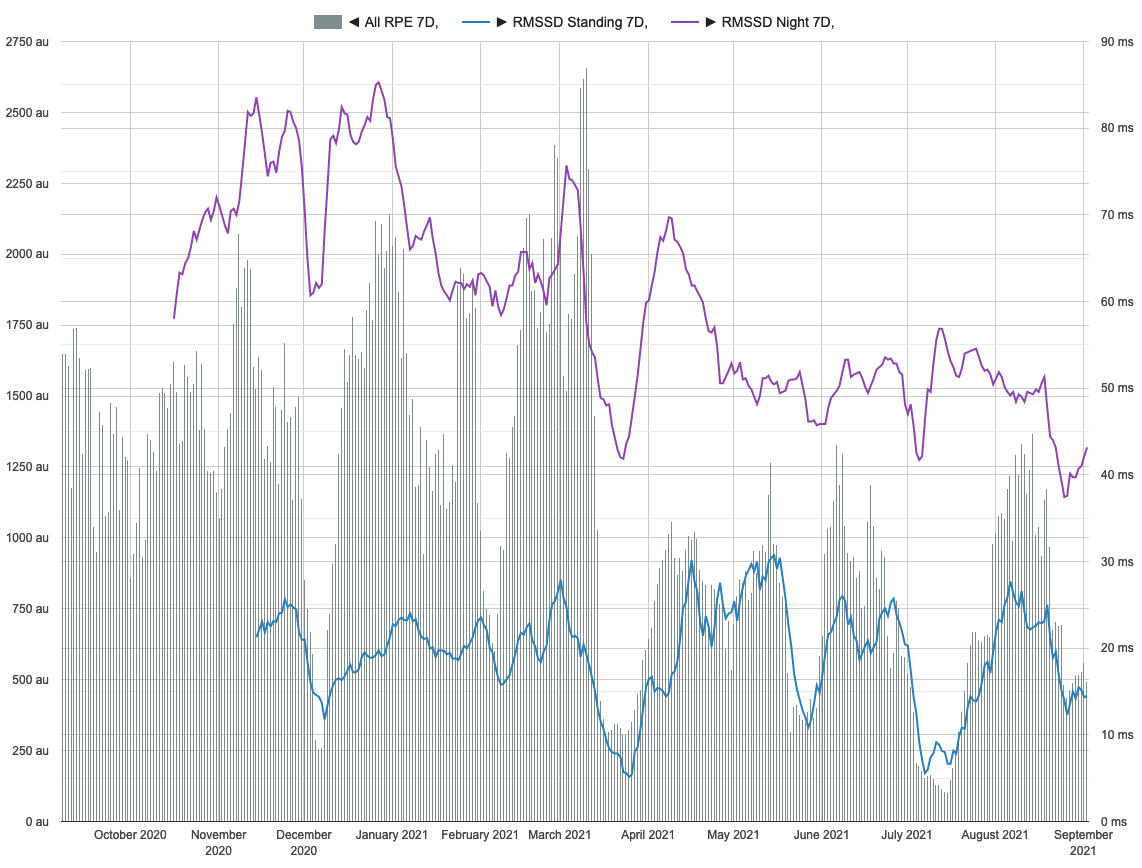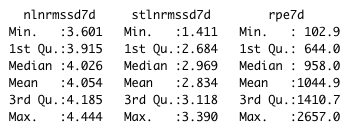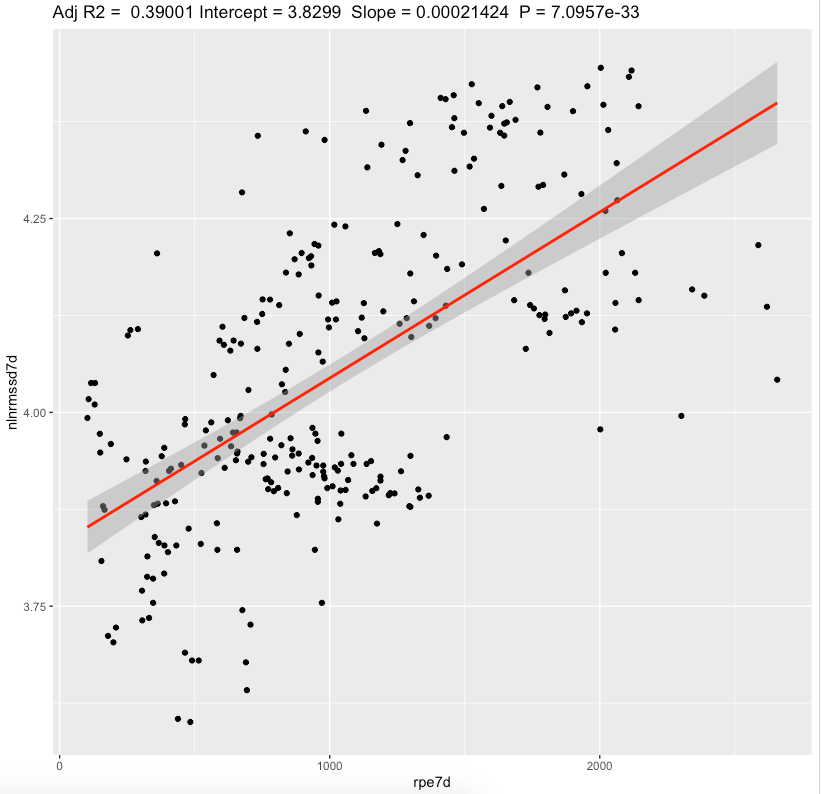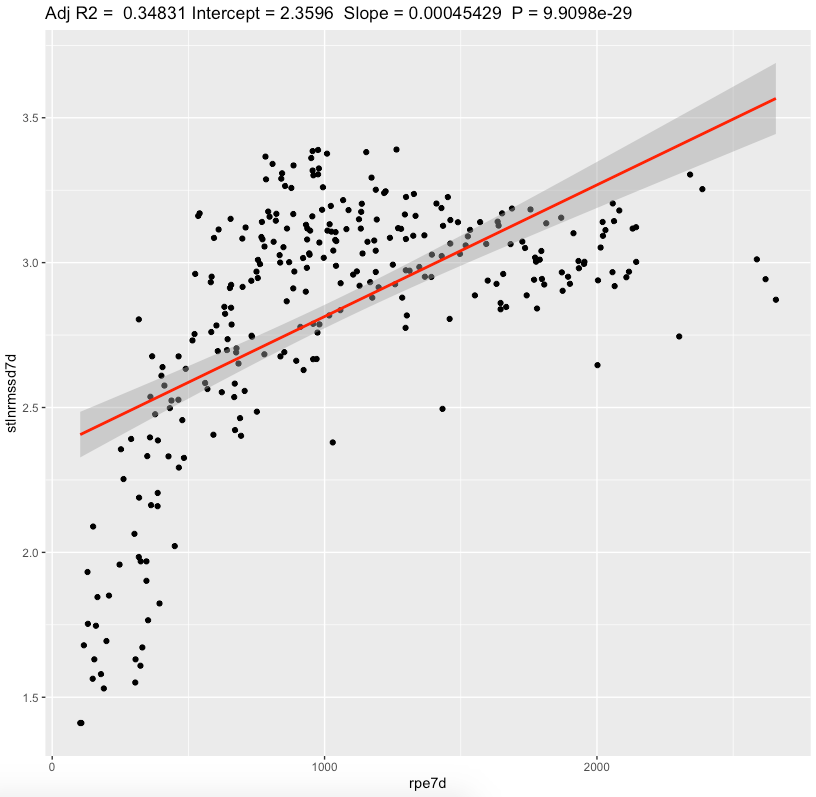Abstract
What did i do?
I've measured my HRV to find out if it correlates with weekly physical activity.
How did i do it?
I've assessed physical activity by using session RPE approach, nightly HRV by using Oura ring and morning standing HRV by using Polar H10.
What did i learn?
There is large positive correlation between weekly HRV and physical activity. Standing values seems to be more sensitive to increased physical activity. 7-day rolling averages provides better insights compared to daily values and strengthens previous findings.
Increase in physical activity leads to increase in HRV as main results of weekly and daily analysis.
Introduction
There is a some evidence that HRV have strong connection with physical activity.
The purpose of this observational data analysis (n=1) is to find if increase in physical activity cause increase in HRV.
Materials & Methods
Participants
Adult male (n=1) anthropometrics was described in previous article
Experimental design
From 2020-09-19 to 2021-09-01 (284 days) daily physical activity was calculated by using sRPE approach, described here. 7-day rolling sum were calculated.
Nightly HRV (RMSSD) was measured by Oura ring on a daily basis. 7-day rolling averages were calculated and log-transformed.
Morning HRV (RMSSD) was measured by Polar H10 in Kubios HRV app, after emptying urinary bladder, within 5 minutes after waking up. Stabilization period was 1 minute and measurement duration was 1 minute. 7-day rolling averages were calculated and log-transformed.
Results
Visual inspection of weekly data is better at revealing connections for metrics then daily window:

The data summary shown below

nlnmrssd7d - 7-day rolling average nightly ln(RMSSD). stlnmrssd7d- 7-day rolling average morning standing ln(RMSSD). rpe7d - 7-day rolling sum sRPE in arbitrary units.
Linear regression, 7-day sRPE
| effect | p-adjusted | effect size | |
| 7-day Nightly ln(RMSSD) | 0.00021 | <0.0001* | substantial |
| 7-day Standing ln(RMSSD) | 0.00045 | <0.0001* | substantial |
We can see a substantial effect slopes for nightly and standing values. Looking at effect values, standing value seems to be more sensitive fo increases in training load. Both metrics showing that increase in sRPE leads to increase in RMSSD. Confidence intervals are pretty narrow. Additional 1-hour training per week with RPE = 6 adds 360au sRPE and increase standing ln(RMSSD) for 500*0.00045 = 0.16 which is equal to ~3ms (+16%)


Pearson's correlation, 7-day sRPE
| r | 95% CI | p-adjusted | effect size | |
| 7-day Nightly ln(RMSSD) | 0.626 | [0.550,0.691] | <0.0001* | large |
| 7-day Standing ln(RMSSD) | 0.592 | [0.511,0.662] | <0.0001* | large |
Correlation analysis shows large correlations for both values. Confidence intervals are narrow enough.
Discussion
The main result of this experiment is a statistically significant association between 7-day rolling average HRV and physical activity. Both values show large correlations with standing RMSSD having better sensivity to changes in physical activity.
In conclusion, there is a powerful connection between weekly HRV and physical activity compared to daily values. Increases in weekly training load result in increased HRV.
Limitations:
- These results are NOT generalizable
- Absence of blinding, randomization, observational nature, n=1
- Often correlation ≠ causation
- Questionnaires widely used in research are prone to participant bias.
- There is a lot of other factors affecting HRV (sleep, diet, caffeine etc) which not taken into account
Data availability & Information
Welcome for questions, suggestions and critics in comments below.
Data is fully available here
library(dplyr)
library(lubridate)
library(effectsize)
library(jsonlite)
ggplotRegression <- function (fit) {
require(ggplot2)
ggplot(fit$model, aes_string(x = names(fit$model)[2], y = names(fit$model)[1])) +
geom_point() +
stat_smooth(method = "lm", col = "red") +
labs(title = paste("Adj R2 = ",signif(summary(fit)$adj.r.squared, 5),
"Intercept =",signif(fit$coef[[1]],5 ),
" Slope =",signif(fit$coef[[2]], 5),
" P =",signif(summary(fit)$coef[2,4], 5)))
}
daily <- read.csv("https://blog.kto.to/uploads/pa-na-rpe-sick-food-step-sauna-meditation-hrv.csv")
daily <- daily[!is.na(daily$`rpe7d`),]
daily <- daily[!is.na(daily$`nlnrmssd7d`),]
daily <- daily[!is.na(daily$`stlnrmssd7d`),]
daily$pa = NULL
daily$na = NULL
daily$food = NULL
daily$steps = NULL
daily$sauna = NULL
daily$meditation = NULL
daily$sick = NULL
daily$rpe = NULL
daily$stlnrmssd = NULL
daily$nlnrmssd = NULL
#daily$rpe7d = NULL
for(i in 1:(nrow(daily)-1))
{
daily$stlnrmssd7d[i] = daily$stlnrmssd7d[i+1]
}
daily <- head(daily,-1)
summary(daily)
l <- lm(cbind(nlnrmssd7d, stlnrmssd7d) ~ rpe7d, data=daily)
summary(anova(l))
s <- summary(l); s
interpret_r2(s$`Response nlnrmssd7d`$adj.r.squared[1])
interpret_r2(s$`Response stlnrmssd7d`$adj.r.squared[1])
p.adjust(c(
s$`Response nlnrmssd7d`$coefficients[,4][2],
s$`Response stlnrmssd7d`$coefficients[,4][2]
), method="BH")
confint(l , level = 0.05)
ggplotRegression(lm(nlnrmssd7d ~ rpe7d, data=daily))
ggplotRegression(lm(stlnrmssd7d ~ rpe7d, data=daily))
c <- cor.test(daily$nlnrmssd7d, daily$rpe7d); c
interpret_r(c$estimate[[1]][1], "cohen1988")
c <- cor.test(daily$stlnrmssd7d, daily$rpe7d); c
interpret_r(c$estimate[[1]][1], "cohen1988")
Response nlnrmssd7d :
Call:
lm(formula = nlnrmssd7d ~ rpe7d, data = daily)
Residuals:
Min 1Q Median 3Q Max
-0.3570 -0.1156 -0.0031 0.1248 0.3697
Coefficients:
Estimate Std. Error t value Pr(>|t|)
(Intercept) 3.830e+00 1.867e-02 205.12 <2e-16 ***
rpe7d 2.142e-04 1.575e-05 13.61 <2e-16 ***
---
Signif. codes: 0 ‘***’ 0.001 ‘**’ 0.01 ‘*’ 0.05 ‘.’ 0.1 ‘ ’ 1
Residual standard error: 0.1501 on 287 degrees of freedom
Multiple R-squared: 0.3921, Adjusted R-squared: 0.39
F-statistic: 185.1 on 1 and 287 DF, p-value: < 2.2e-16
Response stlnrmssd7d :
Call:
lm(formula = stlnrmssd7d ~ rpe7d, data = daily)
Residuals:
Min 1Q Median 3Q Max
-0.9973 -0.2096 0.0289 0.2563 0.6506
Coefficients:
Estimate Std. Error t value Pr(>|t|)
(Intercept) 2.3596339 0.0432812 54.52 <2e-16 ***
rpe7d 0.0004543 0.0000365 12.45 <2e-16 ***
---
Signif. codes: 0 ‘***’ 0.001 ‘**’ 0.01 ‘*’ 0.05 ‘.’ 0.1 ‘ ’ 1
Residual standard error: 0.3479 on 287 degrees of freedom
Multiple R-squared: 0.3506, Adjusted R-squared: 0.3483
F-statistic: 154.9 on 1 and 287 DF, p-value: < 2.2e-16
> interpret_r2(s$`Response nlnrmssd7d`$adj.r.squared[1])
[1] "substantial"
(Rules: cohen1988)
> interpret_r2(s$`Response stlnrmssd7d`$adj.r.squared[1])
[1] "substantial"
(Rules: cohen1988)
>
> p.adjust(c(
+ s$`Response nlnrmssd7d`$coefficients[,4][2],
+ s$`Response stlnrmssd7d`$coefficients[,4][2]
+ ), method="BH")
rpe7d rpe7d
1.419136e-32 9.909802e-29
>
> confint(l , level = 0.05)
47.5 % 52.5 %
nlnrmssd7d:(Intercept) 3.8287566502 3.8311003449
nlnrmssd7d:rpe7d 0.0002132489 0.0002152253
stlnrmssd7d:(Intercept) 2.3569174716 2.3623502642
stlnrmssd7d:rpe7d 0.0004519974 0.0004565788
>
> c <- cor.test(daily$nlnrmssd7d, daily$rpe7d); c
Pearson's product-moment correlation
data: daily$nlnrmssd7d and daily$rpe7d
t = 13.606, df = 287, p-value < 2.2e-16
alternative hypothesis: true correlation is not equal to 0
95 percent confidence interval:
0.5506006 0.6916087
sample estimates:
cor
0.6261986
> interpret_r(c$estimate[[1]][1], "cohen1988")
[1] "large"
(Rules: cohen1988)
>
> c <- cor.test(daily$stlnrmssd7d, daily$rpe7d); c
Pearson's product-moment correlation
data: daily$stlnrmssd7d and daily$rpe7d
t = 12.447, df = 287, p-value < 2.2e-16
alternative hypothesis: true correlation is not equal to 0
95 percent confidence interval:
0.5116630 0.6622272
sample estimates:
cor
0.5920879
> interpret_r(c$estimate[[1]][1], "cohen1988")
[1] "large"
(Rules: cohen1988)
Statistical analysis
RStudio version 1.3.959 and R version 4.0.2 was user for a simple linear regression model and to calculate slopes and p-values.
P-adjusted is p-value adjusted for multiple comparisons by method of Benjamini, Hochberg, and Yekutieli.
Effect sizes based on adjusted R2, Cohen's 1988 rules. Same for Pearson's correlation.